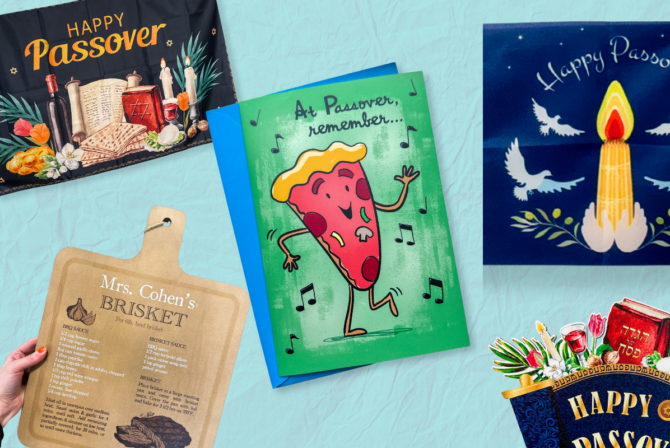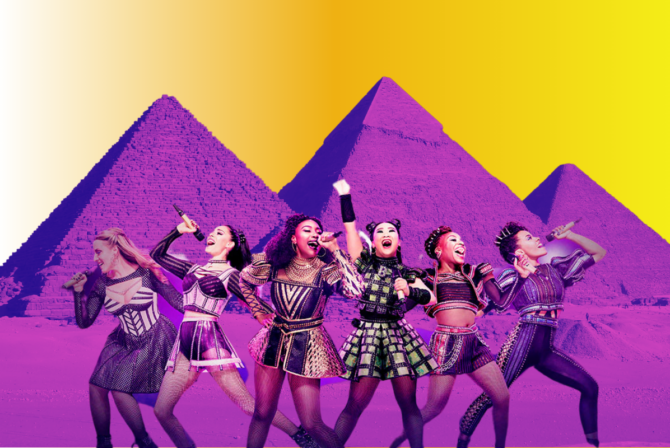I grew up in an assimilated Reform household with some remnants of the Orthodoxy: two sets of dishes, no pork or shellfish (for the first years of my life, at least), and a sincere reverence for Judaism and God that extended to owning clothes that we only were allowed to wear to shul. What my parents didn’t have was a lot of passion for Judaism going on. With all due respect to my parents, they just weren’t that “into” a lot of it. The holidays we observed were enthusiastically celebrated, with a minimum of explanation and even less halachic influence. And so, like so many American Jews, come Passover-time, we used the free Maxwell House Haggadahs that many of you are familiar with.
The English was incomprehensible at times: lots of people “beget”ting other people, insanely confusing translations of Rabbis’ names, and explanations that I now recognize as deep philosophical debates which, as a child, seemed absurd (including the one ending with, “Come gentlemen, it is time to say the morning prayers”–what!?). What was good about Maxwell House? Well, besides it being free, it contained transliterations of songs in “Ashkenazi” Hebrew. My grandparents spoke Yiddish, and it was my mother’s native tongue and my father’s to some extent, so I prayed and sang as they taught me. In addition to its Yiddish-friendly dialect, Maxwell House was compact, had groovy old-school illustrations, and was simply what we used, stop asking questions, let’s finish this thing and go to bed.
In college, once I became more observant, I began to learn about the text of the haggadah: its history, its significance, its logic. And once I became more psychologically aware (also in college), I began to appreciate the haggadah even more: its deeper intentions, its timeless lessons, and its ability to transform a long dinner into a mystical and powerful journey of introspection, growth, and soul-searching.
I have seen many haggadahs since my college days: big ones, small ones, haggadahs all in Hebrew (I’m not ready for that yet), haggadahs with no Hebrew (not ready for that yet, either). The Santa Cruz Haggadah captured my family’s heart with its comic-book style drawings, removal of gendered language, and emphasis on progressive psychology.
Turns out, I am drawn to very traditional haggadahs, though; ones that hold enough supplemental commentary and questions in their margins to keep a seder party going until morning (my family is definitely not ready for that). (I especially love Rabbi Soloveitchik’s Haggadah supplement, the cover of which alone makes my dear family start to nod off.)
So feeling a little bit discouraged and a lot like I was born in Borough Park and transported to a Reform family in Los Angeles, I decided to start compiling bits and pieces of all the haggadahs I loved into a supplement for Passover. I compiled this supplement three years ago, and it included a playful skit about Moses and the burning bush, a bittersweet poem I wrote about my mother’s Pesach observance that was published in a Passover Women’s Anthology, and some other philosophical musings from various and sundry haggadahs. Juggling the supplement along with Maxwell House, though, was frustrating and cumbersome. People kept getting confused about which book we were in and no one seemed to understand my logic of organization. Truth be told, some people didn’t have enough of a grasp on the “order” of the seder (which, ironically, means “order”) to follow what to do when. So it was incumbent upon me to do better.
Last year, I unleashed my first official complete haggadah, which contains all of the required elements (for example, explaining the three symbols of Pesach, the four cups of wine, and reciting Hallel), as well as the poems and songs I love from various other haggadahs, including–yes–Maxwell House. I even included some really cool retro art from old haggadahs, since as a child, one can’t really forget the image of Communist atheists and Nazi soldiers depicted as an example of the heathens God pours out His wrath on, and my haggadah wouldn’t be complete without those historical and bizarrely sentimental images.
And of course, I have included the Ashkenazi transliterations to Chad Gadya, Echad Mi Yodea? and Adir Hu, because singing those like I have for 30 years makes the seder meaningful for me. That was Passover for me when I was a child. But for me, being an adult Jew also means finding new meaning and new inspiration. As someone who has chosen to “return” to traditional Judaism, it means being creative, and satisfying my desire for my own excitement as well as that of my guests while respecting the Jews who came before me and showing my faith in the system of traditional Judaism.
You are probably wondering what my 2 1/2- and 5 1/2-year-old boys think of this whole haggadah business. What if they get bored? What if it’s too long? What if they hate Judaism because they associate holidays with being bored and having things go too long? Well, here’s my answer: Judaism has survived for thousands of years by passing on exactly this information in roughly this way. In addition, it has survived because people have not eliminated the essence of religious observance even under tremendous pressure, either from the outside world or from fussy tired kids. We can do this!
My perspective is this: I have all year to teach my children about Passover; and I use the month leading up to it to practice songs, learn the stories, and find ways for them to connect personally with Passover. I consider it my responsibility to teach them not only the stories and songs though; I get to teach them that the way which we commemorate Passover is in a very special meal that starts late at night and continues past bedtime. I get to be flexible and let them sleep on the couch, on my lap, or in their bed if they choose that as an option. They get to fit into our Jewish life, Jewish life doesn’t change because they are little and present me with a challenge of having little people needs.
Our haggadah includes colorful pictures and fun stuff, but at the seder, our children get to experience what Hebrew sounds like, see what healthy debate and the celebration of intellectualism look like, and learn that they are part of a very big and very distinguished people, even if they are not yet ready to be a full part of it. They have their own small haggadahs with pictures and diagrams of what to do when, and they love everything they stay awake for. They are learning, and I am teaching them.
The freedom we celebrate at Pesach is collective, but it is also personal. My haggadah is a work in progress, just like me. It is a combination of tradition, progress, artistic exploration, and deep passion and love. It is everything I wish to be, and every year, I will keep adding to it to make it the best that it can be. And if it is not perfect, that’s okay; because neither am I.







